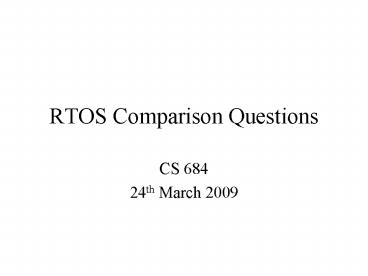RTOS Comparison Questions PowerPoint PPT Presentation
1 / 14
Title: RTOS Comparison Questions
1
RTOS Comparison Questions
- CS 684
- 24th March 2009
2
Outline
- Lynx OS
- VxWorks
- QNX/Neutrino
- VRTX
- RT Linux
- RTAI
- Free RTOS
- UC/OS II
- RTOS Internals
- Miscellaneous
3
Lynx OS
- How does LynxOS offer memory protection through
hardware MMUs? / what is MMU based memory
protection? - What are Kernel Plug-Ins (KPIs)?
- We have KPIs in Lynx OS and similarly in VRTX
each application can add its own system calls.
Are both of them effectively serving the same
way?
4
VxWorks
- VxWorks has backward compatibility to previous
version features for exception handling and
template support. Will that increase the
footprint of the kernel? - In the slides it is given that lynx OS is a self
hosted OS and because of that there is a need for
memory protection. Is VxWorks also a self hosted
OS? Is that the reason for having memory
protection in VxWorks? - As VxWorks uses RR Scheduling, more context
switching should happen, which in turn should
result in more overhead. But in the slides, its
given that VxWorks incurs less overhead. How is
it possible?
5
VxWorks (Contd.)
- Why does RTOSes such as VxWorks and QNX encourage
the use of message queuing or mailboxes as the
primary IPCs? - For VxWorks, reduced context switch time is
achieved by saving only those register windows
which are actually in use (on a Sparc). What do
we mean by Sparc? - Secondly, to increase the response time, it
saves the register windows in a register cache
useful for recurring tasks. What are the
replacement algorithms used for updating the
contents of the cache and avoiding access to
stale data?
6
VxWorks (Contd.)
- What mechanism for IPC is used by VxWorks and how
efficient is it as compared to other RTOSes? - VxWorks uses preemptive round robin scheduling.
Round robin means each task is allocated a time
slot to run on the CPU. If it is a high priority
task then also it will use only the allocated
time slice then other low priority task takes
place. Is the priority rotating or not?In most
of the cases, there is deficiency in RR as
compared to EDF RMS scheduling algorithm. Also,
as RR takes more context switches which in turn
means more latency. In spite of this, VxWorks is
the most popular RTOS. How is it possible?
7
QNX/Neutrino
- The slides say that in QNX/Neutrino, there is
message based priority tracking feature. What is
priority tracking? Why is it necessary? How is it
done based on messages? - How does QNX/Neutrino maximize application
portability ?
8
VRTX
- VRTX has been certified by the US FAA for use in
mission and life critical applications such as
avionics. When there are so many RTOSes, how do
we verify them and select the best one for a
particular application?
9
RT Linux
- How does the use of FIFO in RT Linux ensure that
the real time task is never blocked?
10
RTAI
- How does LXRT in RTAI manages user space
application in kernel space ? - Jitter and latency are low for RTAI than RTLinux.
How can this be justified? - In RTAI, how significant is the overhead of using
the LXRT API?
11
Free RTOS
- Free RTOS has the following feature It offers a
smaller and easier real-time processing
alternative for applications where eCos and
embedded Linux (or RT Linux) won't fit, are not
appropriate, or are not available. What are such
applications, where RT Linux is not appropriate?
What parameters make them inappropriate?
12
UC/OS - II
- UC/OS II features Memory management is performed
using fixed size partitions. What is the typical
size of each partition. Will there be any memory
wastage in the partitions? - Why UC/OS-II is suitable for use in safety
critical embedded system? What are the features
to be considered while selecting RTOS?
13
RTOS Internals
- How does memory management in a RTOS differ from
that in a conventional OS, how is it implemented
across the various RTOS's mentioned. - An operating system can be monolithic or micro
kernel based. Which one is the best for real time
application design ? What is the limitation of
each for real time application and which are
monolithic or micro kernel based from the list
given in the slide ? - Elaborate feedback driven priority assignment.
14
Miscellaneous
- Selection guide (not on cost) and testing
(simulation) tools for COTS RTOS solutions
requested. UC/Probe from Micrium, how it has been
used for Firebird-IV hard RT applications? - Suppose I want to use RTOS in an application like
Nuclear Power Plant. Which should be the RTOS I
should select out of the existing ones?

